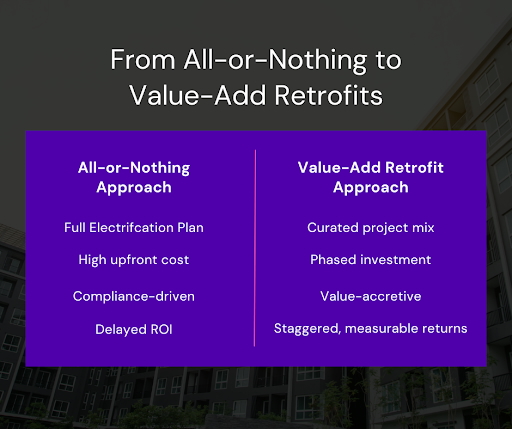Rewriting the Retrofit Playbook: How Value-Accretive Decarbonization Protects Asset Performance
How reframing the energy transition around capital planning, valuation, and risk will define the next generation of real estate leaders.

Decarbonization as a Value Driver, Not a Cost Center
Galvanize Real Estate shows how decarbonization can drive returns—not just meet regulations—by baking it into every deal from day one.

How future-proofing assets can create and drive markets
This newsletter explores the evolving impact of building performance standards (BPS) on real estate, highlighting their role in driving decarbonization and reshaping asset management strategies. It provides actionable insights on compliance, retrofits, and resilience to help property owners and managers navigate this transformative regulatory landscape in 2025 and beyond.

Rewriting the Retrofit Playbook: How Value-Accretive Decarbonization Protects Asset Performance
How reframing the energy transition around capital planning, valuation, and risk will define the next generation of real estate leaders.

How to Talk About Energy & Carbon Transition in a Real Estate Cash Flow Model
By making decarbonization an integral part of financial strategy, Audette helps real estate portfolios move beyond ambition and into execution.

Behind the Curtain: How LP Pressure and GP Collaboration is Accelerating Real Estate Decarbonization
Inside insights from Audette’s panel at the IMN ESG & Decarbonization Forum on how LP mandates and GP structures are shaping real estate decarbonization.

Why Resilience Must Be Central to Every Real Estate Investment Strategy
Real estate leaders Lauren Zullo and Thomas Stanchak join Audette CEO Christopher Naismith to explore how resilience and decarbonization intersect in real estate investment. They share strategies for aligning capital planning with climate risks, overcoming internal barriers, and driving long-term value through sustainable practices.

Unlocking Value Through Decarbonization: Lessons from Galvanize Real Estate
Galvanize Real Estate proves that decarbonization isn’t just good for the planet—it’s smart business. By treating deferred maintenance as a financial opportunity and embedding sustainability into core strategy, they’re showing how CRE firms can cut emissions and boost returns.

The Opportunity in Resilience—Why Physical Risk Mitigation is More Than Just a Cost Center
As insurance markets pull back from high-risk areas, real estate value is shifting fast. This blog explores how physical risk mitigation is becoming essential—and why it’s a strategic advantage, not just a cost.

Navigating Change: Finding High-ROI Opportunities in Decarbonization
The financial landscape of decarbonization is shifting. Companies that act now will secure long-term ROI, while those who delay will face growing financial risks.

The Impact of Building Performance Standards on Asset Value in North America
Building Performance Standards (BPS) are reshaping real estate investment. Learn how asset managers can leverage BPS to protect NOI, boost valuations, and stay competitive.

Shaping a Sustainable Future: Decarbonization Planning in Real Estate
Decarbonization is transforming real estate by shifting the focus from energy efficiency to long-term, sustainable strategies. This blog highlights insights from industry leaders on creating actionable plans, leveraging standards like LEED v5, and driving value through brown-to-green investments. Learn how to align your portfolio with net-zero goals and lead in a low-carbon future.

Driving actionable net zero plans in multifamily real estate
Multifamily real estate faces unique hurdles in the shift to decarbonization. From managing decentralized energy systems to tackling split incentives, it's not just a matter of if—it's about finding the how. Discover how industry leaders are turning complex data into actionable, scalable strategies for a net-zero future.

The three pillars of a scalable decarbonization program
A guide to building a strong decarbonization program in real estate, focusing on efficiency, capital planning, and organizational alignment.

IMN recap: From decarbonization talk to action
Key takeaways from IMN's ESG & Decarbonizing Real Estate Forum: Three best practices for achieving tangible decarbonization outcomes in real estate

Payback is dead, long live payback
Traditional ROI models in real estate often miss the mark by focusing only on short-term utility costs. Discover why a broader perspective on value creation and protection is crucial for effective decarbonization efforts, with insights from industry leaders.

Future-proofing assets: Resilience as a value protection strategy
Join leaders from Jonathan Rose Companies and Stoneweg to discuss resilience as a value protection strategy to ensure future competitiveness.

Dirty-to-clean value-add strategies with Galvanize Real Estate
Learn how Galvanize Real Estate links value-add strategies to decarbonization and long-term performance in today’s market.

Underwriting decarbonization in due diligence
Join Madison International Realty and Crown Realty Partners to explore how ESG factors are shaping investment decisions and underwriting practices.

GRESB, LEED & the future of decarb: Perspectives from real estate standard-setters
Join GRESB, USGBC, and Ember Strategies to discuss the future of decarbonization, rating systems, and investment frameworks.

Decarbonizing Multifamily real estate: Navigating challenges & opportunities
Hear from AvalonBay and Greystar on how large multifamily portfolios are navigating climate risk and decarbonization goals.

Carbon's impact on future asset values: Early market signals & emerging trends
Tishman Speyer and Lendlease Americas break down how carbon and ESG trends are already shaping asset values.


